Analyzing the Role of Packaging in Building the Pringles Brand
VerifiedAdded on 2020/01/28
|63
|19285
|447
Case Study
AI Summary
This case study examines the role of packaging in building the Pringles brand, a product of P&G. It explores how packaging elements like design, shape, and labeling influence consumer perception and brand identity. The research employs an inductive approach, utilizing primary data from customer questionnaires and interviews with P&G managers, along with secondary data sources. The study investigates the impact of packaging on attracting consumers, differentiating products, and ultimately, boosting sales. The objectives include identifying key packaging features, analyzing brand-building factors, assessing packaging's role in brand development, and recommending effective packaging strategies for Pringles. The findings emphasize the importance of packaging in the competitive FMCG market and its contribution to product recognition and brand loyalty. The report includes a literature review, research methodology, data analysis, and conclusions with recommendations for enhancing Pringles' packaging strategy.
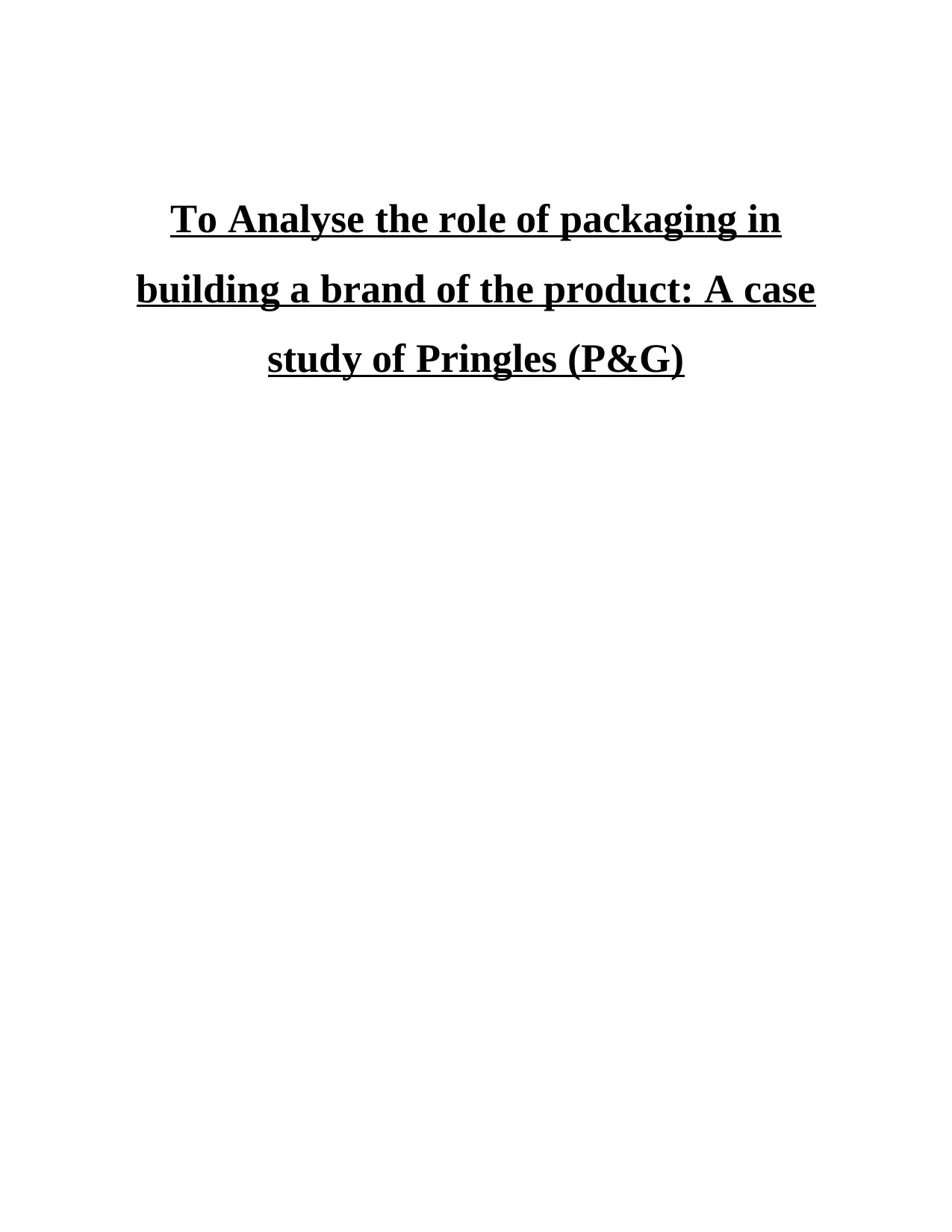
To Analyse the role of packaging in
building a brand of the product: A case
study of Pringles (P&G)
building a brand of the product: A case
study of Pringles (P&G)
Paraphrase This Document
Need a fresh take? Get an instant paraphrase of this document with our AI Paraphraser
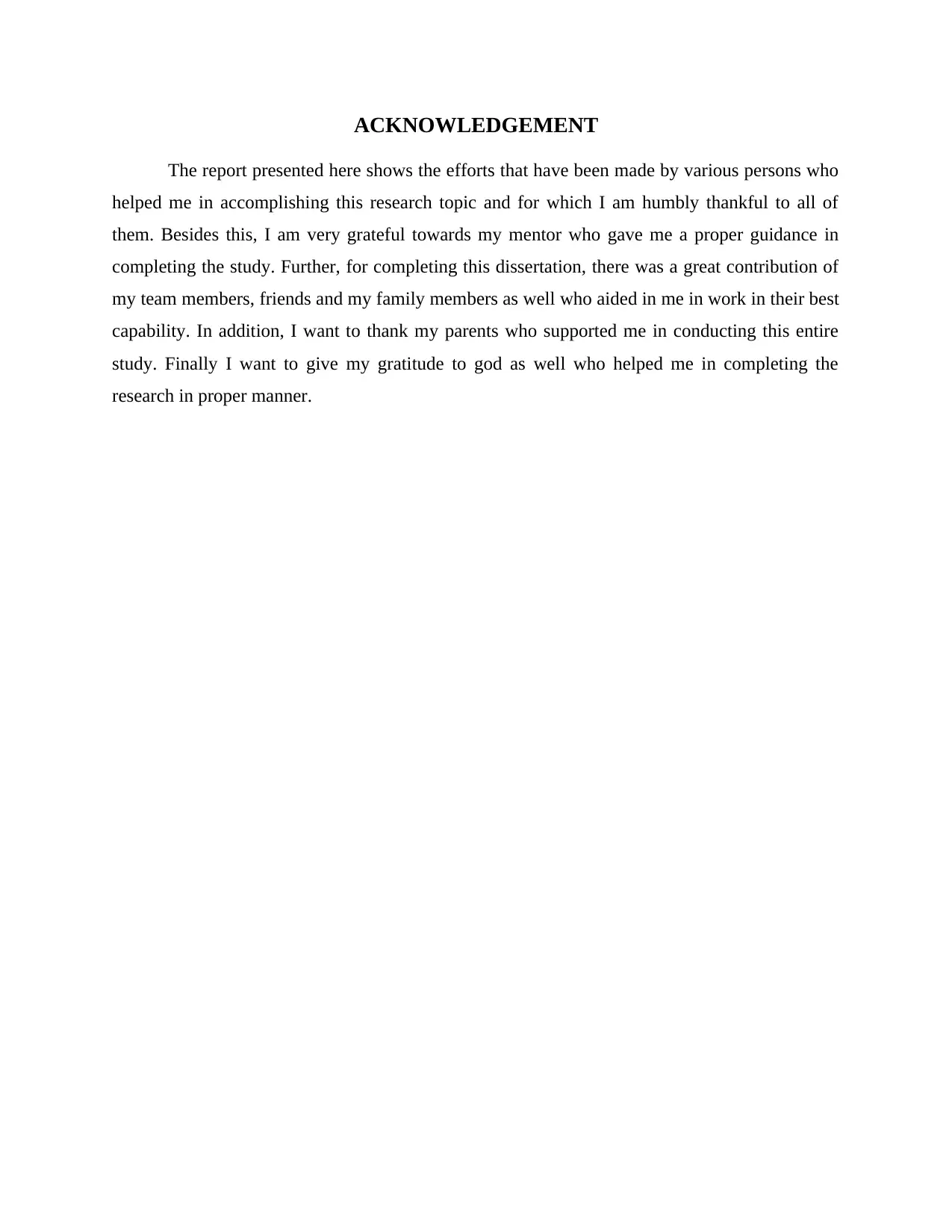
ACKNOWLEDGEMENT
The report presented here shows the efforts that have been made by various persons who
helped me in accomplishing this research topic and for which I am humbly thankful to all of
them. Besides this, I am very grateful towards my mentor who gave me a proper guidance in
completing the study. Further, for completing this dissertation, there was a great contribution of
my team members, friends and my family members as well who aided in me in work in their best
capability. In addition, I want to thank my parents who supported me in conducting this entire
study. Finally I want to give my gratitude to god as well who helped me in completing the
research in proper manner.
The report presented here shows the efforts that have been made by various persons who
helped me in accomplishing this research topic and for which I am humbly thankful to all of
them. Besides this, I am very grateful towards my mentor who gave me a proper guidance in
completing the study. Further, for completing this dissertation, there was a great contribution of
my team members, friends and my family members as well who aided in me in work in their best
capability. In addition, I want to thank my parents who supported me in conducting this entire
study. Finally I want to give my gratitude to god as well who helped me in completing the
research in proper manner.
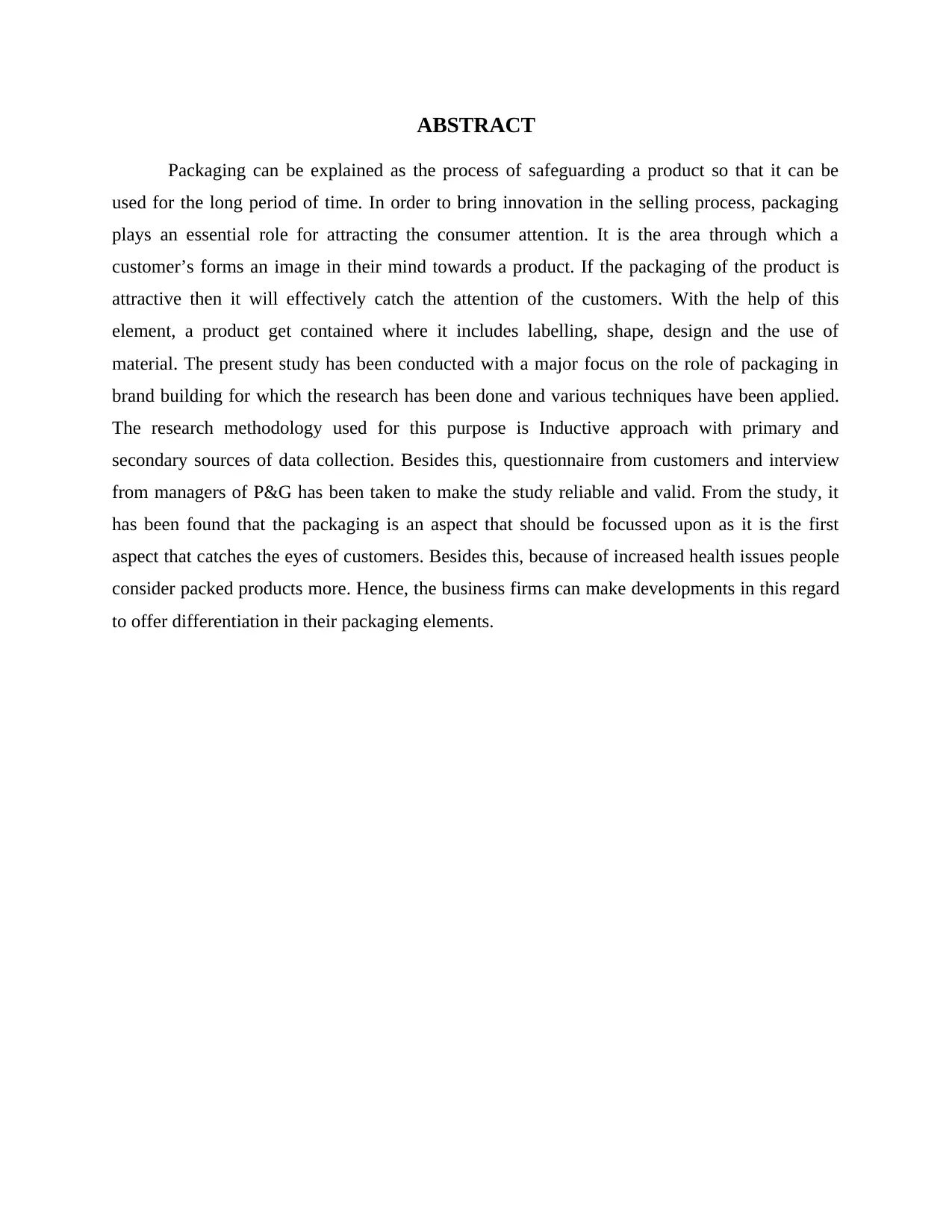
ABSTRACT
Packaging can be explained as the process of safeguarding a product so that it can be
used for the long period of time. In order to bring innovation in the selling process, packaging
plays an essential role for attracting the consumer attention. It is the area through which a
customer’s forms an image in their mind towards a product. If the packaging of the product is
attractive then it will effectively catch the attention of the customers. With the help of this
element, a product get contained where it includes labelling, shape, design and the use of
material. The present study has been conducted with a major focus on the role of packaging in
brand building for which the research has been done and various techniques have been applied.
The research methodology used for this purpose is Inductive approach with primary and
secondary sources of data collection. Besides this, questionnaire from customers and interview
from managers of P&G has been taken to make the study reliable and valid. From the study, it
has been found that the packaging is an aspect that should be focussed upon as it is the first
aspect that catches the eyes of customers. Besides this, because of increased health issues people
consider packed products more. Hence, the business firms can make developments in this regard
to offer differentiation in their packaging elements.
Packaging can be explained as the process of safeguarding a product so that it can be
used for the long period of time. In order to bring innovation in the selling process, packaging
plays an essential role for attracting the consumer attention. It is the area through which a
customer’s forms an image in their mind towards a product. If the packaging of the product is
attractive then it will effectively catch the attention of the customers. With the help of this
element, a product get contained where it includes labelling, shape, design and the use of
material. The present study has been conducted with a major focus on the role of packaging in
brand building for which the research has been done and various techniques have been applied.
The research methodology used for this purpose is Inductive approach with primary and
secondary sources of data collection. Besides this, questionnaire from customers and interview
from managers of P&G has been taken to make the study reliable and valid. From the study, it
has been found that the packaging is an aspect that should be focussed upon as it is the first
aspect that catches the eyes of customers. Besides this, because of increased health issues people
consider packed products more. Hence, the business firms can make developments in this regard
to offer differentiation in their packaging elements.
⊘ This is a preview!⊘
Do you want full access?
Subscribe today to unlock all pages.

Trusted by 1+ million students worldwide
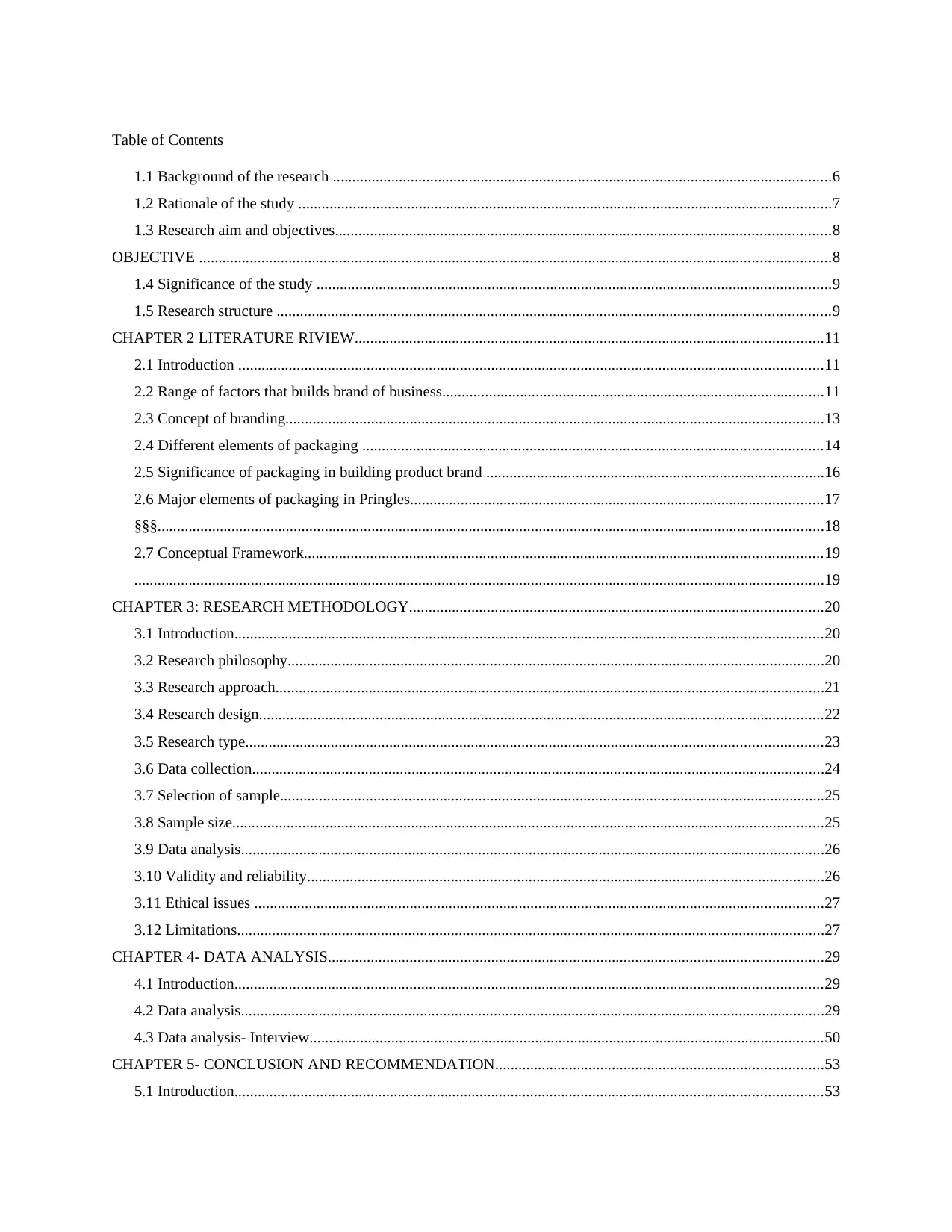
Table of Contents
1.1 Background of the research ................................................................................................................................6
1.2 Rationale of the study .........................................................................................................................................7
1.3 Research aim and objectives...............................................................................................................................8
OBJECTIVE ..................................................................................................................................................................8
1.4 Significance of the study ....................................................................................................................................9
1.5 Research structure ..............................................................................................................................................9
CHAPTER 2 LITERATURE RIVIEW........................................................................................................................11
2.1 Introduction ......................................................................................................................................................11
2.2 Range of factors that builds brand of business..................................................................................................11
2.3 Concept of branding..........................................................................................................................................13
2.4 Different elements of packaging ......................................................................................................................14
2.5 Significance of packaging in building product brand .......................................................................................16
2.6 Major elements of packaging in Pringles..........................................................................................................17
§§§...........................................................................................................................................................................18
2.7 Conceptual Framework.....................................................................................................................................19
.................................................................................................................................................................................19
CHAPTER 3: RESEARCH METHODOLOGY..........................................................................................................20
3.1 Introduction.......................................................................................................................................................20
3.2 Research philosophy..........................................................................................................................................20
3.3 Research approach.............................................................................................................................................21
3.4 Research design.................................................................................................................................................22
3.5 Research type....................................................................................................................................................23
3.6 Data collection...................................................................................................................................................24
3.7 Selection of sample............................................................................................................................................25
3.8 Sample size........................................................................................................................................................25
3.9 Data analysis......................................................................................................................................................26
3.10 Validity and reliability.....................................................................................................................................26
3.11 Ethical issues ..................................................................................................................................................27
3.12 Limitations.......................................................................................................................................................27
CHAPTER 4- DATA ANALYSIS...............................................................................................................................29
4.1 Introduction.......................................................................................................................................................29
4.2 Data analysis......................................................................................................................................................29
4.3 Data analysis- Interview....................................................................................................................................50
CHAPTER 5- CONCLUSION AND RECOMMENDATION....................................................................................53
5.1 Introduction.......................................................................................................................................................53
1.1 Background of the research ................................................................................................................................6
1.2 Rationale of the study .........................................................................................................................................7
1.3 Research aim and objectives...............................................................................................................................8
OBJECTIVE ..................................................................................................................................................................8
1.4 Significance of the study ....................................................................................................................................9
1.5 Research structure ..............................................................................................................................................9
CHAPTER 2 LITERATURE RIVIEW........................................................................................................................11
2.1 Introduction ......................................................................................................................................................11
2.2 Range of factors that builds brand of business..................................................................................................11
2.3 Concept of branding..........................................................................................................................................13
2.4 Different elements of packaging ......................................................................................................................14
2.5 Significance of packaging in building product brand .......................................................................................16
2.6 Major elements of packaging in Pringles..........................................................................................................17
§§§...........................................................................................................................................................................18
2.7 Conceptual Framework.....................................................................................................................................19
.................................................................................................................................................................................19
CHAPTER 3: RESEARCH METHODOLOGY..........................................................................................................20
3.1 Introduction.......................................................................................................................................................20
3.2 Research philosophy..........................................................................................................................................20
3.3 Research approach.............................................................................................................................................21
3.4 Research design.................................................................................................................................................22
3.5 Research type....................................................................................................................................................23
3.6 Data collection...................................................................................................................................................24
3.7 Selection of sample............................................................................................................................................25
3.8 Sample size........................................................................................................................................................25
3.9 Data analysis......................................................................................................................................................26
3.10 Validity and reliability.....................................................................................................................................26
3.11 Ethical issues ..................................................................................................................................................27
3.12 Limitations.......................................................................................................................................................27
CHAPTER 4- DATA ANALYSIS...............................................................................................................................29
4.1 Introduction.......................................................................................................................................................29
4.2 Data analysis......................................................................................................................................................29
4.3 Data analysis- Interview....................................................................................................................................50
CHAPTER 5- CONCLUSION AND RECOMMENDATION....................................................................................53
5.1 Introduction.......................................................................................................................................................53
Paraphrase This Document
Need a fresh take? Get an instant paraphrase of this document with our AI Paraphraser

5.2 Conclusion.........................................................................................................................................................53
5.3 Recommendations.............................................................................................................................................55
REFERENCES..............................................................................................................................................................57
5.3 Recommendations.............................................................................................................................................55
REFERENCES..............................................................................................................................................................57
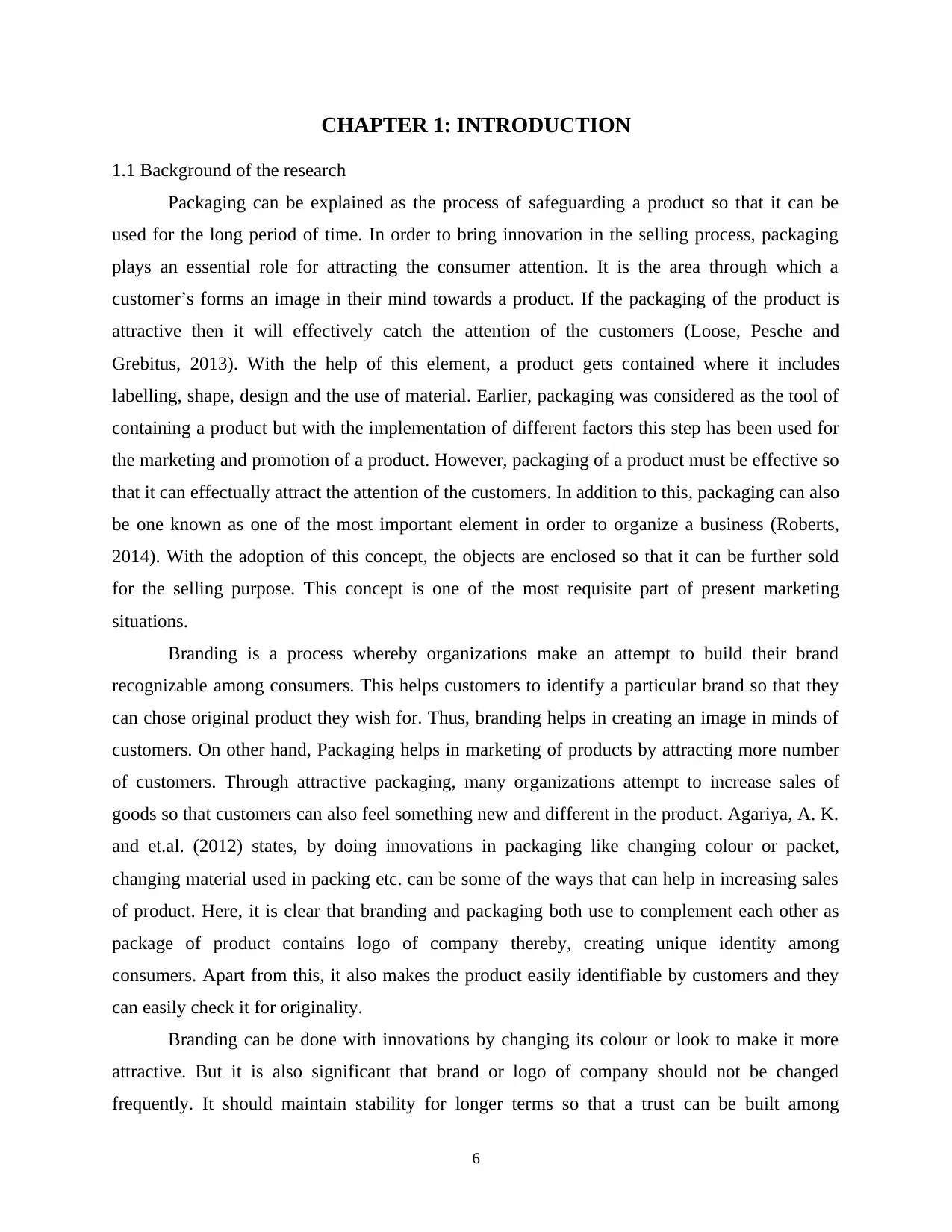
CHAPTER 1: INTRODUCTION
1.1 Background of the research
Packaging can be explained as the process of safeguarding a product so that it can be
used for the long period of time. In order to bring innovation in the selling process, packaging
plays an essential role for attracting the consumer attention. It is the area through which a
customer’s forms an image in their mind towards a product. If the packaging of the product is
attractive then it will effectively catch the attention of the customers (Loose, Pesche and
Grebitus, 2013). With the help of this element, a product gets contained where it includes
labelling, shape, design and the use of material. Earlier, packaging was considered as the tool of
containing a product but with the implementation of different factors this step has been used for
the marketing and promotion of a product. However, packaging of a product must be effective so
that it can effectually attract the attention of the customers. In addition to this, packaging can also
be one known as one of the most important element in order to organize a business (Roberts,
2014). With the adoption of this concept, the objects are enclosed so that it can be further sold
for the selling purpose. This concept is one of the most requisite part of present marketing
situations.
Branding is a process whereby organizations make an attempt to build their brand
recognizable among consumers. This helps customers to identify a particular brand so that they
can chose original product they wish for. Thus, branding helps in creating an image in minds of
customers. On other hand, Packaging helps in marketing of products by attracting more number
of customers. Through attractive packaging, many organizations attempt to increase sales of
goods so that customers can also feel something new and different in the product. Agariya, A. K.
and et.al. (2012) states, by doing innovations in packaging like changing colour or packet,
changing material used in packing etc. can be some of the ways that can help in increasing sales
of product. Here, it is clear that branding and packaging both use to complement each other as
package of product contains logo of company thereby, creating unique identity among
consumers. Apart from this, it also makes the product easily identifiable by customers and they
can easily check it for originality.
Branding can be done with innovations by changing its colour or look to make it more
attractive. But it is also significant that brand or logo of company should not be changed
frequently. It should maintain stability for longer terms so that a trust can be built among
6
1.1 Background of the research
Packaging can be explained as the process of safeguarding a product so that it can be
used for the long period of time. In order to bring innovation in the selling process, packaging
plays an essential role for attracting the consumer attention. It is the area through which a
customer’s forms an image in their mind towards a product. If the packaging of the product is
attractive then it will effectively catch the attention of the customers (Loose, Pesche and
Grebitus, 2013). With the help of this element, a product gets contained where it includes
labelling, shape, design and the use of material. Earlier, packaging was considered as the tool of
containing a product but with the implementation of different factors this step has been used for
the marketing and promotion of a product. However, packaging of a product must be effective so
that it can effectually attract the attention of the customers. In addition to this, packaging can also
be one known as one of the most important element in order to organize a business (Roberts,
2014). With the adoption of this concept, the objects are enclosed so that it can be further sold
for the selling purpose. This concept is one of the most requisite part of present marketing
situations.
Branding is a process whereby organizations make an attempt to build their brand
recognizable among consumers. This helps customers to identify a particular brand so that they
can chose original product they wish for. Thus, branding helps in creating an image in minds of
customers. On other hand, Packaging helps in marketing of products by attracting more number
of customers. Through attractive packaging, many organizations attempt to increase sales of
goods so that customers can also feel something new and different in the product. Agariya, A. K.
and et.al. (2012) states, by doing innovations in packaging like changing colour or packet,
changing material used in packing etc. can be some of the ways that can help in increasing sales
of product. Here, it is clear that branding and packaging both use to complement each other as
package of product contains logo of company thereby, creating unique identity among
consumers. Apart from this, it also makes the product easily identifiable by customers and they
can easily check it for originality.
Branding can be done with innovations by changing its colour or look to make it more
attractive. But it is also significant that brand or logo of company should not be changed
frequently. It should maintain stability for longer terms so that a trust can be built among
6
⊘ This is a preview!⊘
Do you want full access?
Subscribe today to unlock all pages.

Trusted by 1+ million students worldwide
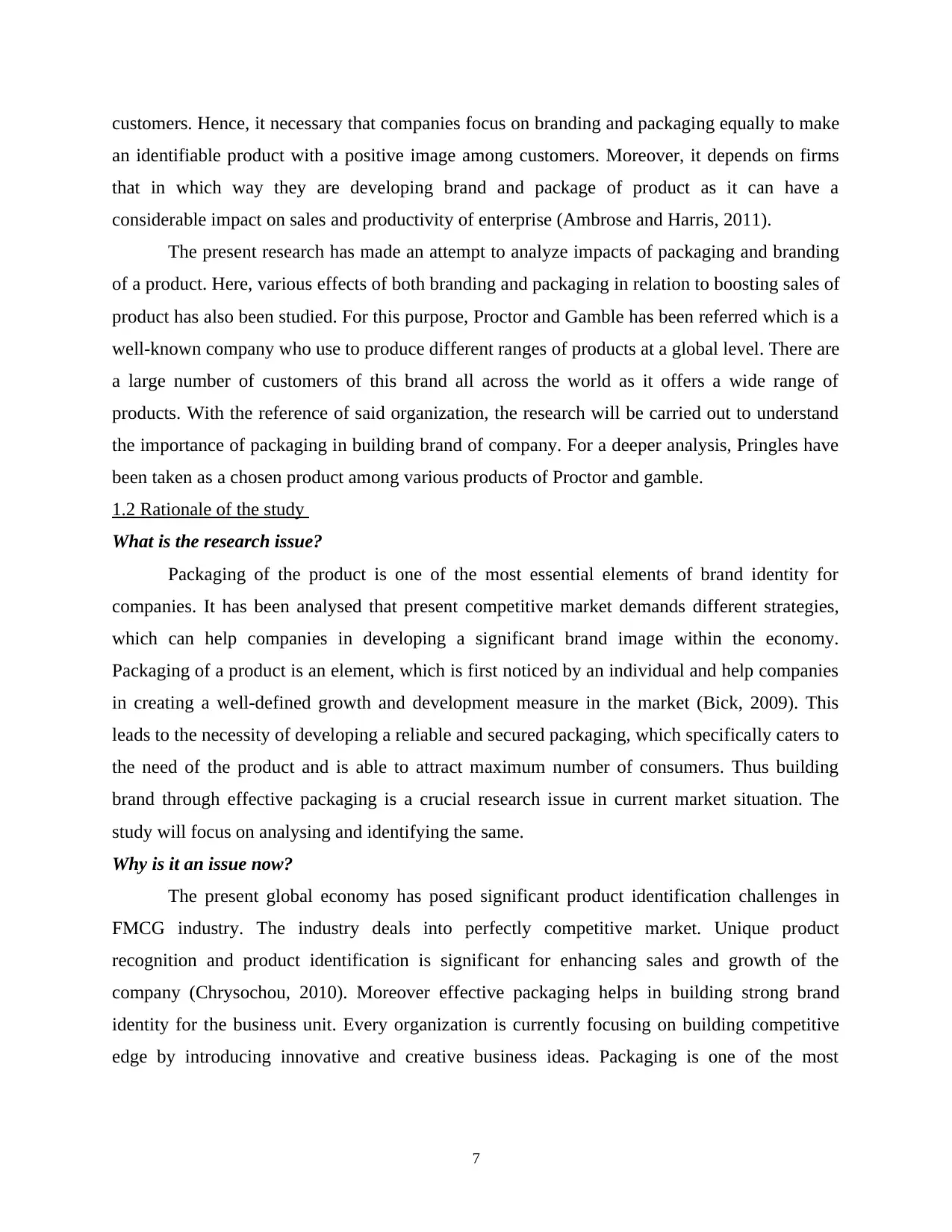
customers. Hence, it necessary that companies focus on branding and packaging equally to make
an identifiable product with a positive image among customers. Moreover, it depends on firms
that in which way they are developing brand and package of product as it can have a
considerable impact on sales and productivity of enterprise (Ambrose and Harris, 2011).
The present research has made an attempt to analyze impacts of packaging and branding
of a product. Here, various effects of both branding and packaging in relation to boosting sales of
product has also been studied. For this purpose, Proctor and Gamble has been referred which is a
well-known company who use to produce different ranges of products at a global level. There are
a large number of customers of this brand all across the world as it offers a wide range of
products. With the reference of said organization, the research will be carried out to understand
the importance of packaging in building brand of company. For a deeper analysis, Pringles have
been taken as a chosen product among various products of Proctor and gamble.
1.2 Rationale of the study
What is the research issue?
Packaging of the product is one of the most essential elements of brand identity for
companies. It has been analysed that present competitive market demands different strategies,
which can help companies in developing a significant brand image within the economy.
Packaging of a product is an element, which is first noticed by an individual and help companies
in creating a well-defined growth and development measure in the market (Bick, 2009). This
leads to the necessity of developing a reliable and secured packaging, which specifically caters to
the need of the product and is able to attract maximum number of consumers. Thus building
brand through effective packaging is a crucial research issue in current market situation. The
study will focus on analysing and identifying the same.
Why is it an issue now?
The present global economy has posed significant product identification challenges in
FMCG industry. The industry deals into perfectly competitive market. Unique product
recognition and product identification is significant for enhancing sales and growth of the
company (Chrysochou, 2010). Moreover effective packaging helps in building strong brand
identity for the business unit. Every organization is currently focusing on building competitive
edge by introducing innovative and creative business ideas. Packaging is one of the most
7
an identifiable product with a positive image among customers. Moreover, it depends on firms
that in which way they are developing brand and package of product as it can have a
considerable impact on sales and productivity of enterprise (Ambrose and Harris, 2011).
The present research has made an attempt to analyze impacts of packaging and branding
of a product. Here, various effects of both branding and packaging in relation to boosting sales of
product has also been studied. For this purpose, Proctor and Gamble has been referred which is a
well-known company who use to produce different ranges of products at a global level. There are
a large number of customers of this brand all across the world as it offers a wide range of
products. With the reference of said organization, the research will be carried out to understand
the importance of packaging in building brand of company. For a deeper analysis, Pringles have
been taken as a chosen product among various products of Proctor and gamble.
1.2 Rationale of the study
What is the research issue?
Packaging of the product is one of the most essential elements of brand identity for
companies. It has been analysed that present competitive market demands different strategies,
which can help companies in developing a significant brand image within the economy.
Packaging of a product is an element, which is first noticed by an individual and help companies
in creating a well-defined growth and development measure in the market (Bick, 2009). This
leads to the necessity of developing a reliable and secured packaging, which specifically caters to
the need of the product and is able to attract maximum number of consumers. Thus building
brand through effective packaging is a crucial research issue in current market situation. The
study will focus on analysing and identifying the same.
Why is it an issue now?
The present global economy has posed significant product identification challenges in
FMCG industry. The industry deals into perfectly competitive market. Unique product
recognition and product identification is significant for enhancing sales and growth of the
company (Chrysochou, 2010). Moreover effective packaging helps in building strong brand
identity for the business unit. Every organization is currently focusing on building competitive
edge by introducing innovative and creative business ideas. Packaging is one of the most
7
Paraphrase This Document
Need a fresh take? Get an instant paraphrase of this document with our AI Paraphraser
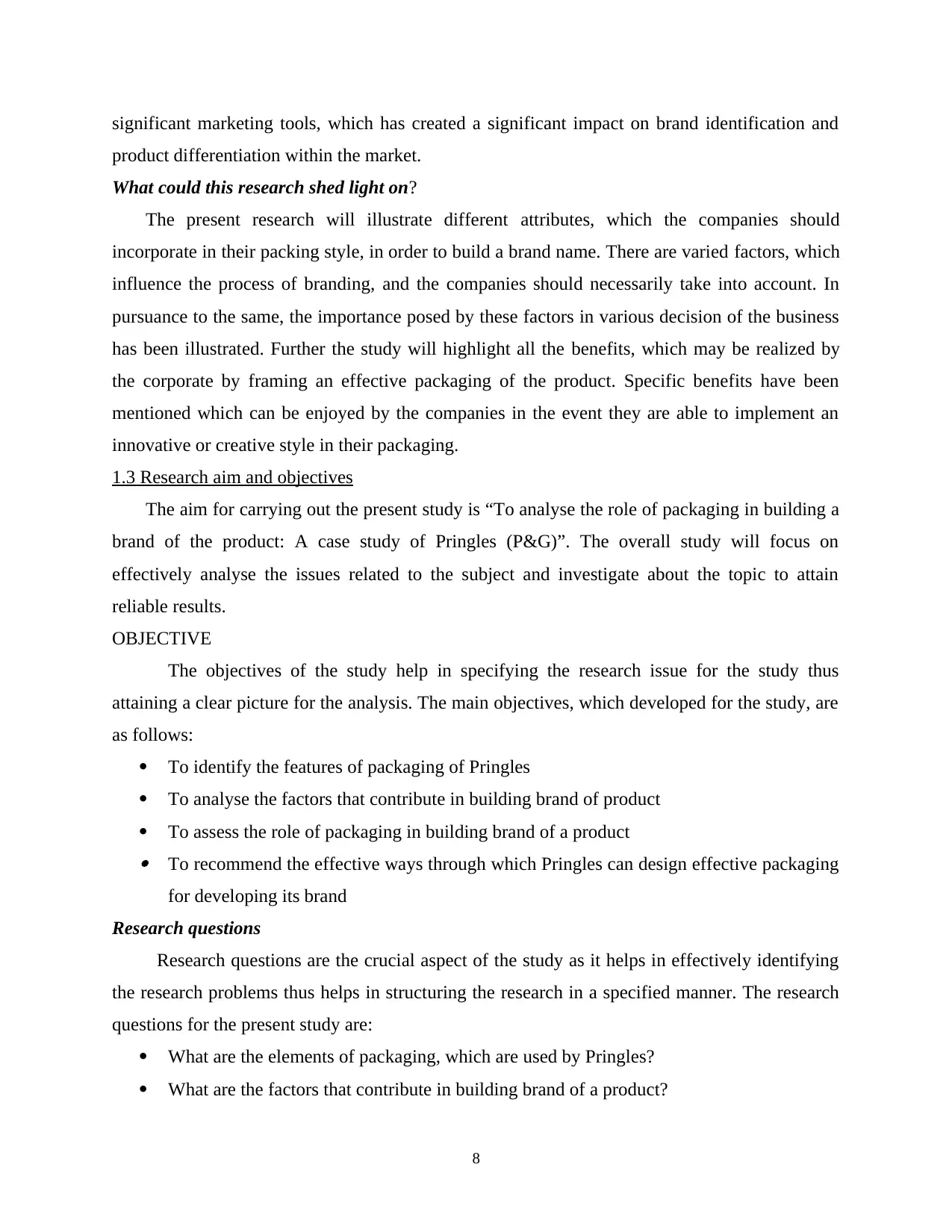
significant marketing tools, which has created a significant impact on brand identification and
product differentiation within the market.
What could this research shed light on?
The present research will illustrate different attributes, which the companies should
incorporate in their packing style, in order to build a brand name. There are varied factors, which
influence the process of branding, and the companies should necessarily take into account. In
pursuance to the same, the importance posed by these factors in various decision of the business
has been illustrated. Further the study will highlight all the benefits, which may be realized by
the corporate by framing an effective packaging of the product. Specific benefits have been
mentioned which can be enjoyed by the companies in the event they are able to implement an
innovative or creative style in their packaging.
1.3 Research aim and objectives
The aim for carrying out the present study is “To analyse the role of packaging in building a
brand of the product: A case study of Pringles (P&G)”. The overall study will focus on
effectively analyse the issues related to the subject and investigate about the topic to attain
reliable results.
OBJECTIVE
The objectives of the study help in specifying the research issue for the study thus
attaining a clear picture for the analysis. The main objectives, which developed for the study, are
as follows:
To identify the features of packaging of Pringles
To analyse the factors that contribute in building brand of product
To assess the role of packaging in building brand of a product To recommend the effective ways through which Pringles can design effective packaging
for developing its brand
Research questions
Research questions are the crucial aspect of the study as it helps in effectively identifying
the research problems thus helps in structuring the research in a specified manner. The research
questions for the present study are:
What are the elements of packaging, which are used by Pringles?
What are the factors that contribute in building brand of a product?
8
product differentiation within the market.
What could this research shed light on?
The present research will illustrate different attributes, which the companies should
incorporate in their packing style, in order to build a brand name. There are varied factors, which
influence the process of branding, and the companies should necessarily take into account. In
pursuance to the same, the importance posed by these factors in various decision of the business
has been illustrated. Further the study will highlight all the benefits, which may be realized by
the corporate by framing an effective packaging of the product. Specific benefits have been
mentioned which can be enjoyed by the companies in the event they are able to implement an
innovative or creative style in their packaging.
1.3 Research aim and objectives
The aim for carrying out the present study is “To analyse the role of packaging in building a
brand of the product: A case study of Pringles (P&G)”. The overall study will focus on
effectively analyse the issues related to the subject and investigate about the topic to attain
reliable results.
OBJECTIVE
The objectives of the study help in specifying the research issue for the study thus
attaining a clear picture for the analysis. The main objectives, which developed for the study, are
as follows:
To identify the features of packaging of Pringles
To analyse the factors that contribute in building brand of product
To assess the role of packaging in building brand of a product To recommend the effective ways through which Pringles can design effective packaging
for developing its brand
Research questions
Research questions are the crucial aspect of the study as it helps in effectively identifying
the research problems thus helps in structuring the research in a specified manner. The research
questions for the present study are:
What are the elements of packaging, which are used by Pringles?
What are the factors that contribute in building brand of a product?
8
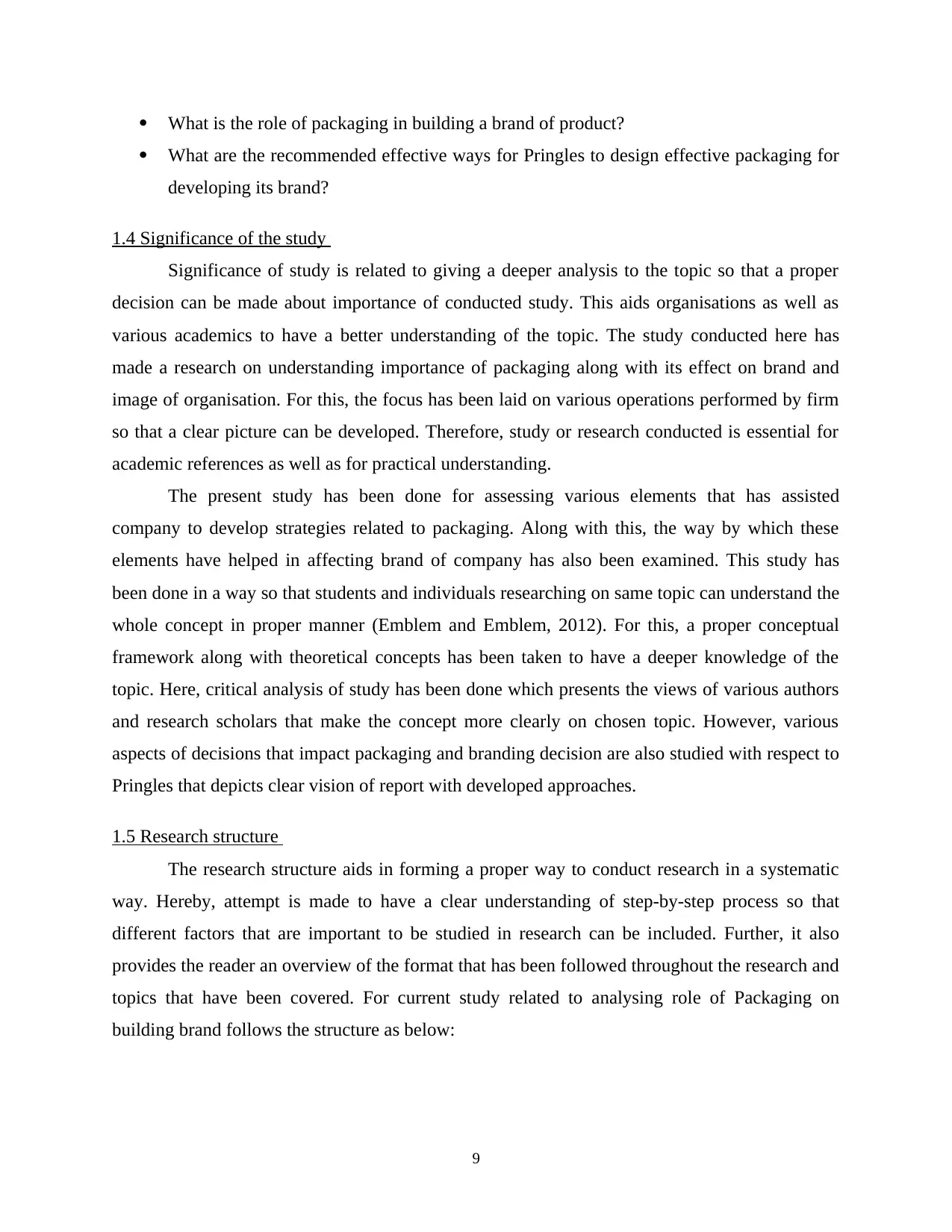
What is the role of packaging in building a brand of product?
What are the recommended effective ways for Pringles to design effective packaging for
developing its brand?
1.4 Significance of the study
Significance of study is related to giving a deeper analysis to the topic so that a proper
decision can be made about importance of conducted study. This aids organisations as well as
various academics to have a better understanding of the topic. The study conducted here has
made a research on understanding importance of packaging along with its effect on brand and
image of organisation. For this, the focus has been laid on various operations performed by firm
so that a clear picture can be developed. Therefore, study or research conducted is essential for
academic references as well as for practical understanding.
The present study has been done for assessing various elements that has assisted
company to develop strategies related to packaging. Along with this, the way by which these
elements have helped in affecting brand of company has also been examined. This study has
been done in a way so that students and individuals researching on same topic can understand the
whole concept in proper manner (Emblem and Emblem, 2012). For this, a proper conceptual
framework along with theoretical concepts has been taken to have a deeper knowledge of the
topic. Here, critical analysis of study has been done which presents the views of various authors
and research scholars that make the concept more clearly on chosen topic. However, various
aspects of decisions that impact packaging and branding decision are also studied with respect to
Pringles that depicts clear vision of report with developed approaches.
1.5 Research structure
The research structure aids in forming a proper way to conduct research in a systematic
way. Hereby, attempt is made to have a clear understanding of step-by-step process so that
different factors that are important to be studied in research can be included. Further, it also
provides the reader an overview of the format that has been followed throughout the research and
topics that have been covered. For current study related to analysing role of Packaging on
building brand follows the structure as below:
9
What are the recommended effective ways for Pringles to design effective packaging for
developing its brand?
1.4 Significance of the study
Significance of study is related to giving a deeper analysis to the topic so that a proper
decision can be made about importance of conducted study. This aids organisations as well as
various academics to have a better understanding of the topic. The study conducted here has
made a research on understanding importance of packaging along with its effect on brand and
image of organisation. For this, the focus has been laid on various operations performed by firm
so that a clear picture can be developed. Therefore, study or research conducted is essential for
academic references as well as for practical understanding.
The present study has been done for assessing various elements that has assisted
company to develop strategies related to packaging. Along with this, the way by which these
elements have helped in affecting brand of company has also been examined. This study has
been done in a way so that students and individuals researching on same topic can understand the
whole concept in proper manner (Emblem and Emblem, 2012). For this, a proper conceptual
framework along with theoretical concepts has been taken to have a deeper knowledge of the
topic. Here, critical analysis of study has been done which presents the views of various authors
and research scholars that make the concept more clearly on chosen topic. However, various
aspects of decisions that impact packaging and branding decision are also studied with respect to
Pringles that depicts clear vision of report with developed approaches.
1.5 Research structure
The research structure aids in forming a proper way to conduct research in a systematic
way. Hereby, attempt is made to have a clear understanding of step-by-step process so that
different factors that are important to be studied in research can be included. Further, it also
provides the reader an overview of the format that has been followed throughout the research and
topics that have been covered. For current study related to analysing role of Packaging on
building brand follows the structure as below:
9
⊘ This is a preview!⊘
Do you want full access?
Subscribe today to unlock all pages.

Trusted by 1+ million students worldwide
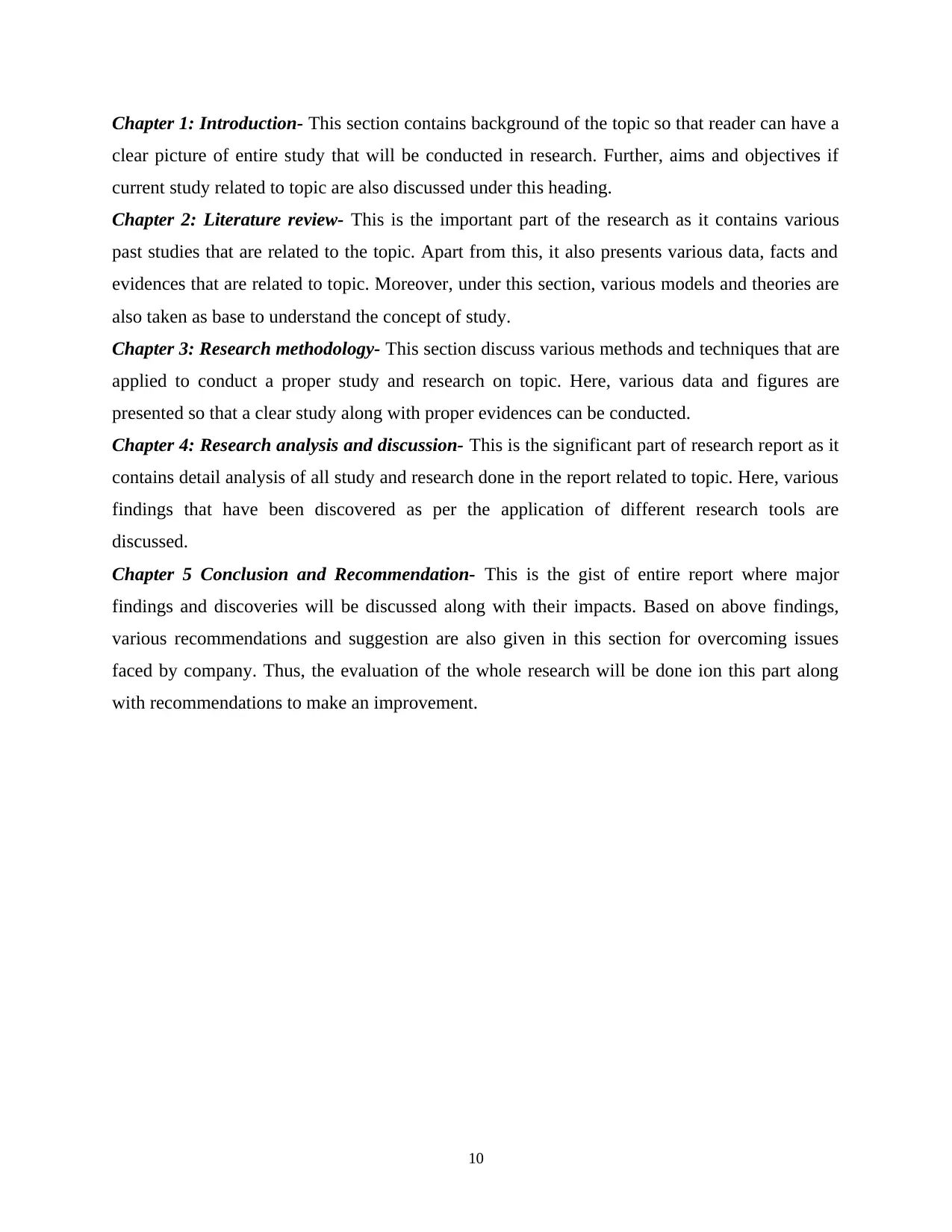
Chapter 1: Introduction- This section contains background of the topic so that reader can have a
clear picture of entire study that will be conducted in research. Further, aims and objectives if
current study related to topic are also discussed under this heading.
Chapter 2: Literature review- This is the important part of the research as it contains various
past studies that are related to the topic. Apart from this, it also presents various data, facts and
evidences that are related to topic. Moreover, under this section, various models and theories are
also taken as base to understand the concept of study.
Chapter 3: Research methodology- This section discuss various methods and techniques that are
applied to conduct a proper study and research on topic. Here, various data and figures are
presented so that a clear study along with proper evidences can be conducted.
Chapter 4: Research analysis and discussion- This is the significant part of research report as it
contains detail analysis of all study and research done in the report related to topic. Here, various
findings that have been discovered as per the application of different research tools are
discussed.
Chapter 5 Conclusion and Recommendation- This is the gist of entire report where major
findings and discoveries will be discussed along with their impacts. Based on above findings,
various recommendations and suggestion are also given in this section for overcoming issues
faced by company. Thus, the evaluation of the whole research will be done ion this part along
with recommendations to make an improvement.
10
clear picture of entire study that will be conducted in research. Further, aims and objectives if
current study related to topic are also discussed under this heading.
Chapter 2: Literature review- This is the important part of the research as it contains various
past studies that are related to the topic. Apart from this, it also presents various data, facts and
evidences that are related to topic. Moreover, under this section, various models and theories are
also taken as base to understand the concept of study.
Chapter 3: Research methodology- This section discuss various methods and techniques that are
applied to conduct a proper study and research on topic. Here, various data and figures are
presented so that a clear study along with proper evidences can be conducted.
Chapter 4: Research analysis and discussion- This is the significant part of research report as it
contains detail analysis of all study and research done in the report related to topic. Here, various
findings that have been discovered as per the application of different research tools are
discussed.
Chapter 5 Conclusion and Recommendation- This is the gist of entire report where major
findings and discoveries will be discussed along with their impacts. Based on above findings,
various recommendations and suggestion are also given in this section for overcoming issues
faced by company. Thus, the evaluation of the whole research will be done ion this part along
with recommendations to make an improvement.
10
Paraphrase This Document
Need a fresh take? Get an instant paraphrase of this document with our AI Paraphraser
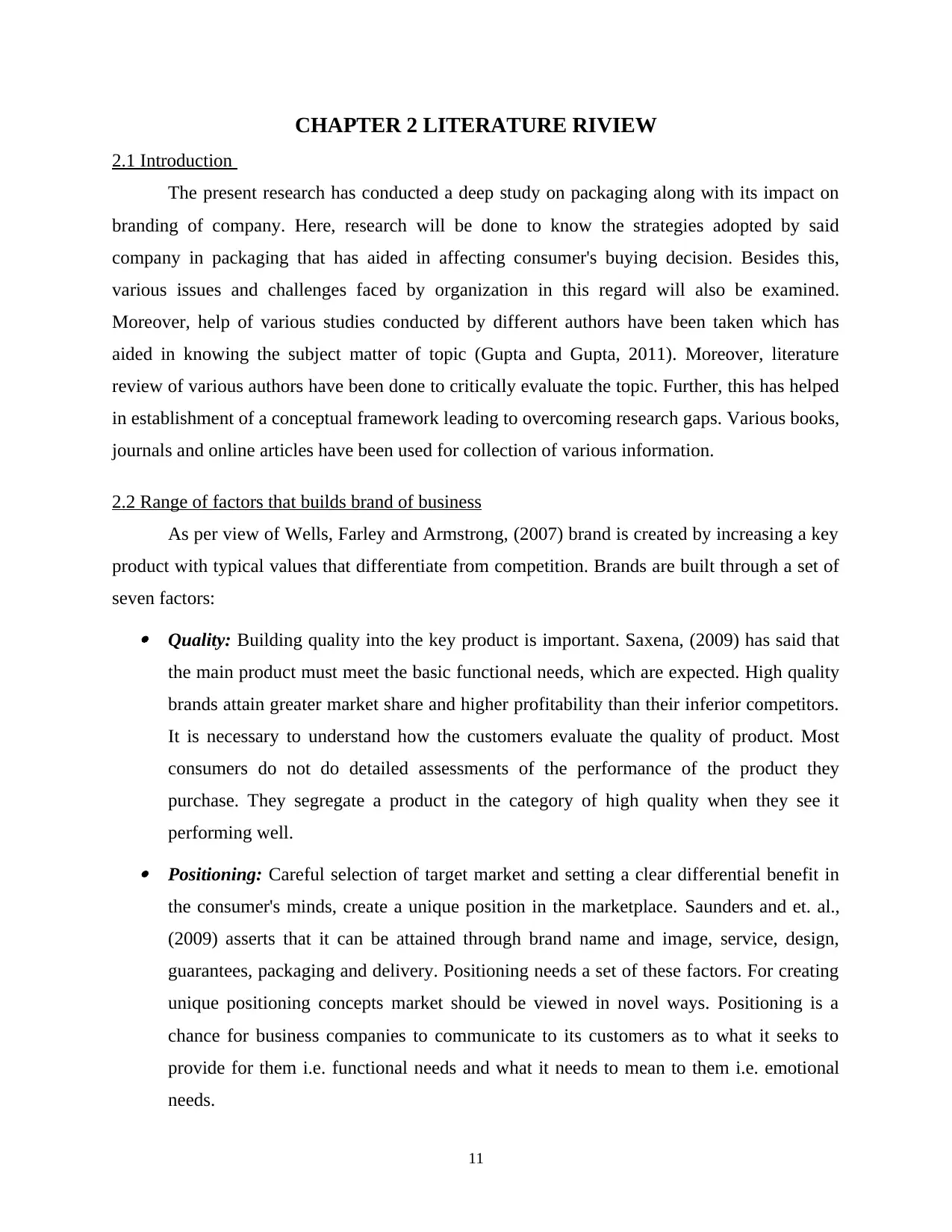
CHAPTER 2 LITERATURE RIVIEW
2.1 Introduction
The present research has conducted a deep study on packaging along with its impact on
branding of company. Here, research will be done to know the strategies adopted by said
company in packaging that has aided in affecting consumer's buying decision. Besides this,
various issues and challenges faced by organization in this regard will also be examined.
Moreover, help of various studies conducted by different authors have been taken which has
aided in knowing the subject matter of topic (Gupta and Gupta, 2011). Moreover, literature
review of various authors have been done to critically evaluate the topic. Further, this has helped
in establishment of a conceptual framework leading to overcoming research gaps. Various books,
journals and online articles have been used for collection of various information.
2.2 Range of factors that builds brand of business
As per view of Wells, Farley and Armstrong, (2007) brand is created by increasing a key
product with typical values that differentiate from competition. Brands are built through a set of
seven factors: Quality: Building quality into the key product is important. Saxena, (2009) has said that
the main product must meet the basic functional needs, which are expected. High quality
brands attain greater market share and higher profitability than their inferior competitors.
It is necessary to understand how the customers evaluate the quality of product. Most
consumers do not do detailed assessments of the performance of the product they
purchase. They segregate a product in the category of high quality when they see it
performing well. Positioning: Careful selection of target market and setting a clear differential benefit in
the consumer's minds, create a unique position in the marketplace. Saunders and et. al.,
(2009) asserts that it can be attained through brand name and image, service, design,
guarantees, packaging and delivery. Positioning needs a set of these factors. For creating
unique positioning concepts market should be viewed in novel ways. Positioning is a
chance for business companies to communicate to its customers as to what it seeks to
provide for them i.e. functional needs and what it needs to mean to them i.e. emotional
needs.
11
2.1 Introduction
The present research has conducted a deep study on packaging along with its impact on
branding of company. Here, research will be done to know the strategies adopted by said
company in packaging that has aided in affecting consumer's buying decision. Besides this,
various issues and challenges faced by organization in this regard will also be examined.
Moreover, help of various studies conducted by different authors have been taken which has
aided in knowing the subject matter of topic (Gupta and Gupta, 2011). Moreover, literature
review of various authors have been done to critically evaluate the topic. Further, this has helped
in establishment of a conceptual framework leading to overcoming research gaps. Various books,
journals and online articles have been used for collection of various information.
2.2 Range of factors that builds brand of business
As per view of Wells, Farley and Armstrong, (2007) brand is created by increasing a key
product with typical values that differentiate from competition. Brands are built through a set of
seven factors: Quality: Building quality into the key product is important. Saxena, (2009) has said that
the main product must meet the basic functional needs, which are expected. High quality
brands attain greater market share and higher profitability than their inferior competitors.
It is necessary to understand how the customers evaluate the quality of product. Most
consumers do not do detailed assessments of the performance of the product they
purchase. They segregate a product in the category of high quality when they see it
performing well. Positioning: Careful selection of target market and setting a clear differential benefit in
the consumer's minds, create a unique position in the marketplace. Saunders and et. al.,
(2009) asserts that it can be attained through brand name and image, service, design,
guarantees, packaging and delivery. Positioning needs a set of these factors. For creating
unique positioning concepts market should be viewed in novel ways. Positioning is a
chance for business companies to communicate to its customers as to what it seeks to
provide for them i.e. functional needs and what it needs to mean to them i.e. emotional
needs.
11
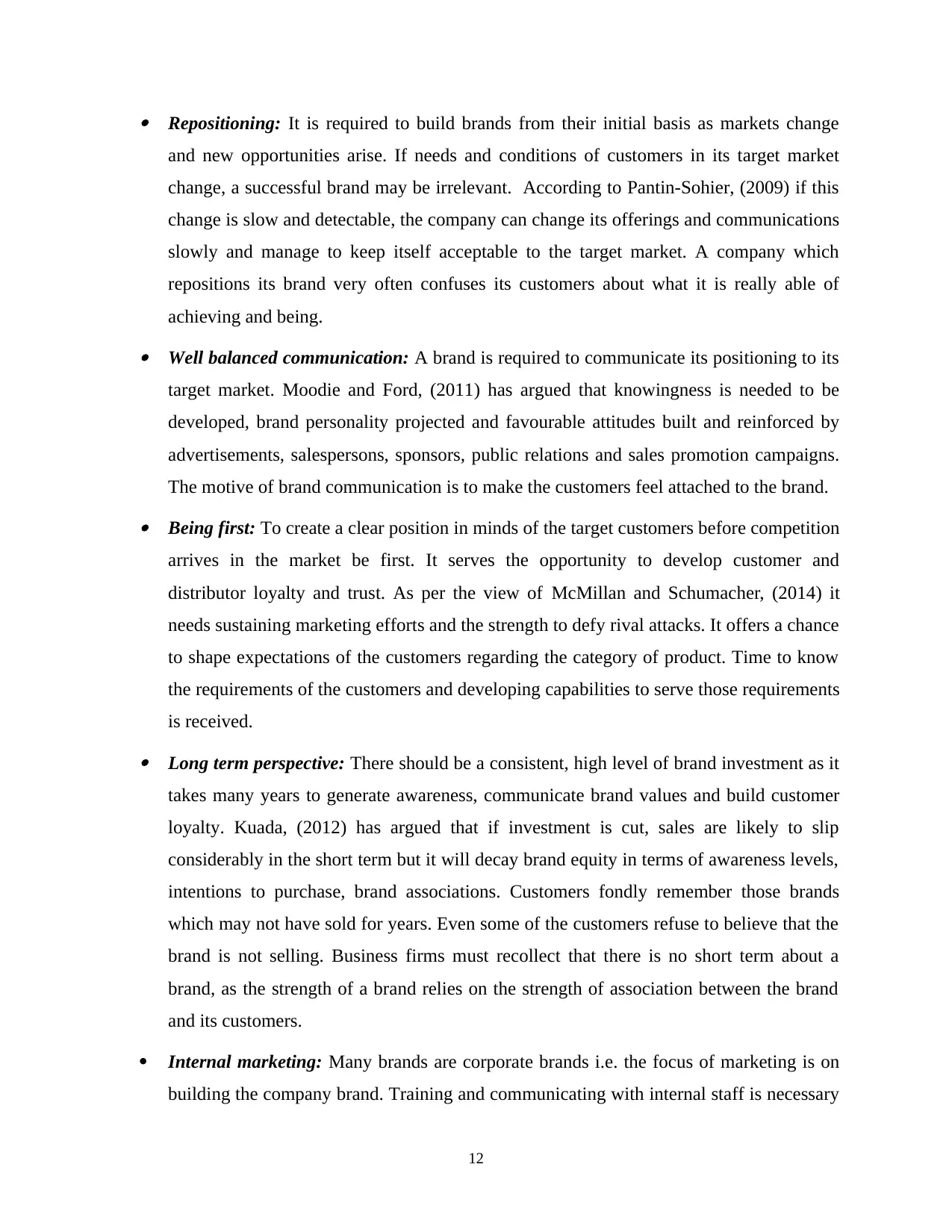
Repositioning: It is required to build brands from their initial basis as markets change
and new opportunities arise. If needs and conditions of customers in its target market
change, a successful brand may be irrelevant. According to Pantin-Sohier, (2009) if this
change is slow and detectable, the company can change its offerings and communications
slowly and manage to keep itself acceptable to the target market. A company which
repositions its brand very often confuses its customers about what it is really able of
achieving and being. Well balanced communication: A brand is required to communicate its positioning to its
target market. Moodie and Ford, (2011) has argued that knowingness is needed to be
developed, brand personality projected and favourable attitudes built and reinforced by
advertisements, salespersons, sponsors, public relations and sales promotion campaigns.
The motive of brand communication is to make the customers feel attached to the brand. Being first: To create a clear position in minds of the target customers before competition
arrives in the market be first. It serves the opportunity to develop customer and
distributor loyalty and trust. As per the view of McMillan and Schumacher, (2014) it
needs sustaining marketing efforts and the strength to defy rival attacks. It offers a chance
to shape expectations of the customers regarding the category of product. Time to know
the requirements of the customers and developing capabilities to serve those requirements
is received. Long term perspective: There should be a consistent, high level of brand investment as it
takes many years to generate awareness, communicate brand values and build customer
loyalty. Kuada, (2012) has argued that if investment is cut, sales are likely to slip
considerably in the short term but it will decay brand equity in terms of awareness levels,
intentions to purchase, brand associations. Customers fondly remember those brands
which may not have sold for years. Even some of the customers refuse to believe that the
brand is not selling. Business firms must recollect that there is no short term about a
brand, as the strength of a brand relies on the strength of association between the brand
and its customers.
Internal marketing: Many brands are corporate brands i.e. the focus of marketing is on
building the company brand. Training and communicating with internal staff is necessary
12
and new opportunities arise. If needs and conditions of customers in its target market
change, a successful brand may be irrelevant. According to Pantin-Sohier, (2009) if this
change is slow and detectable, the company can change its offerings and communications
slowly and manage to keep itself acceptable to the target market. A company which
repositions its brand very often confuses its customers about what it is really able of
achieving and being. Well balanced communication: A brand is required to communicate its positioning to its
target market. Moodie and Ford, (2011) has argued that knowingness is needed to be
developed, brand personality projected and favourable attitudes built and reinforced by
advertisements, salespersons, sponsors, public relations and sales promotion campaigns.
The motive of brand communication is to make the customers feel attached to the brand. Being first: To create a clear position in minds of the target customers before competition
arrives in the market be first. It serves the opportunity to develop customer and
distributor loyalty and trust. As per the view of McMillan and Schumacher, (2014) it
needs sustaining marketing efforts and the strength to defy rival attacks. It offers a chance
to shape expectations of the customers regarding the category of product. Time to know
the requirements of the customers and developing capabilities to serve those requirements
is received. Long term perspective: There should be a consistent, high level of brand investment as it
takes many years to generate awareness, communicate brand values and build customer
loyalty. Kuada, (2012) has argued that if investment is cut, sales are likely to slip
considerably in the short term but it will decay brand equity in terms of awareness levels,
intentions to purchase, brand associations. Customers fondly remember those brands
which may not have sold for years. Even some of the customers refuse to believe that the
brand is not selling. Business firms must recollect that there is no short term about a
brand, as the strength of a brand relies on the strength of association between the brand
and its customers.
Internal marketing: Many brands are corporate brands i.e. the focus of marketing is on
building the company brand. Training and communicating with internal staff is necessary
12
⊘ This is a preview!⊘
Do you want full access?
Subscribe today to unlock all pages.

Trusted by 1+ million students worldwide
1 out of 63
Related Documents
Your All-in-One AI-Powered Toolkit for Academic Success.
+13062052269
info@desklib.com
Available 24*7 on WhatsApp / Email
![[object Object]](/_next/static/media/star-bottom.7253800d.svg)
Unlock your academic potential
Copyright © 2020–2025 A2Z Services. All Rights Reserved. Developed and managed by ZUCOL.





